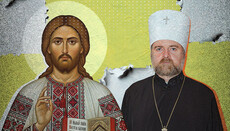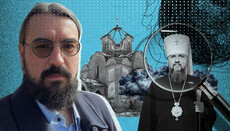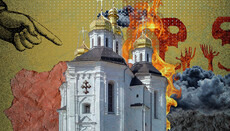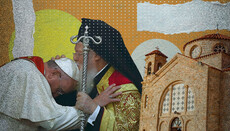History repeats itself: Met. Tychikos's deposition and lessons of the past
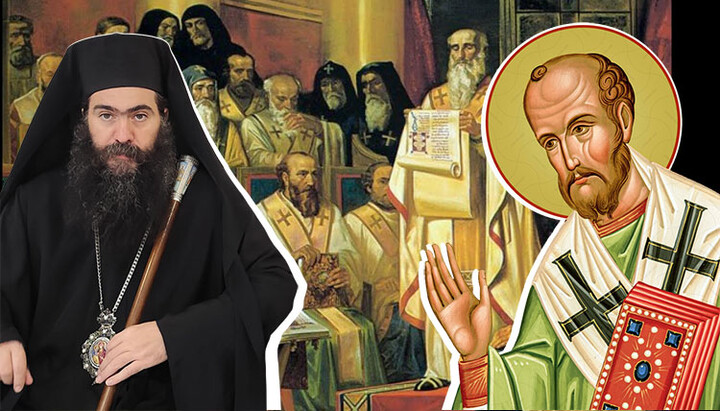
After the Synod of Cyprus removed Metropolitan Tychikos of Paphos from leadership, many publications have already been released. It makes sense to look at similar cases in history to understand the meaning of what is happening.
On May 22, 2025, the Holy Synod of the Cyprus Orthodox Church, in an extraordinary session, decided by a vote of 10 to 6 to remove Metropolitan Tychikos of Paphos from his episcopal see.
According to media reports, Metropolitan Tychikos was accused of undermining the authority of the Primate of the Cyprus Church, Archbishop Georgios, and thus violating the canonical unity of the Church. It was also reported that the leadership of the Church of Cyprus finally lost patience after Tikhik refused to accept the relics of the Apostle Paul into his diocese, which were to be brought by a Catholic cardinal. This arrangement had previously been made between the now-deceased Archbishop Chrysostomos II and Pope Francis.
Incidentally, in the history of the Church, gifting relics and other artifacts (or their temporary transfer for veneration) was often used to resolve other issues: political, military, and so on. For example, in the 4th century, to elevate Constantinople as the new capital of the empire, Emperor Constantius II (son of Constantine the Great) began to bring there the relics of the most famous saints: the Apostle Andrew the First-Called, the Apostle Timothy (a disciple of the Apostle Paul), the Holy Great Martyr Irene, and so on.
In 1023, Emperor Romanos III Argyros received a portion of the relics of St. George from the Armenian ruler of Edessa in exchange for diplomatic support and recognition of his authority. In medieval Europe, relics – often counterfeit – were widely used as a form of currency to resolve both major and minor matters. This practice continues in modern times. For example, in 2004, as part of efforts toward ecumenical rapprochement with the Ecumenical Patriarchate, Pope John Paul II returned the relics of St. John Chrysostom, which had been looted by the Crusaders in 1204. And on July 1, 2019, Pope Francis gave Patriarch Bartholomew a fragment of the relics of the Apostle Peter.
Therefore, one of the reasons for Metropolitan Tychikos's refusal to accept the Catholic cardinal with the relics of the Apostle Paul may have been not only the unwillingness to pray with him, which is banned by the canons, but also the unwillingness to participate in the conditional scheme: "relics in exchange for ecumenical rapprochement".
It is clear that to depose someone, other accusations had to be invented. And so complaints against Metropolitan Tychikos are brought to light, alleging that he supposedly does not allow marriages between Orthodox and non-Orthodox in his diocese, does not recognize non-Orthodox baptisms, re-baptizes those coming into Orthodoxy from Protestant denominations, and so on.
It is worth noting that not a single accusation to discredit Metropolitan Tychikos was brought against him. He was not accused of financial misconduct, immoral relationships, ambition for power, or anything of the sort. And that is quite surprising. There was no attempt to discredit him – he was directly accused of remaining faithful to canonical rules that have never been abolished. For example, both in ancient times and today, one of the most effective methods of discrediting someone is to use corrupt women who claim to have had a relationship with the individual. Here are just a few saints who endured such a trial:
· St. Martin of Jerusalem (4th century);
· St. Martin the Merciful, Bishop of Tours (4th century);
· St. Moses the Black (4th century);
· St. Niphont of Cyprus (4th–5th centuries);
· St. Simeon the Stylite (5th century);
· St. John the Hut-Dweller (5th century).
Another popular method is the accusation of financial abuse and embezzlement. Such was experienced, for example, by:
· St. John Chrysostom (4th–5th centuries);
· St. Nicephorus the Confessor (8th–9th centuries);
· St. Ambrose of Milan (4th century);
· St. Gregory the Theologian (4th century).
Closer to our times, there are also saints who were accused of financial misconduct by both church and secular authorities. Here are some examples:
· St. Arsenius Matseyevich, Archbishop of Rostov (†1772);
· St. Paisius Velichkovsky (†1794);
· St. Joasaph of Belgorod (†1754);
· St. Tikhon, Patriarch of All Russia (†1925);
· St. Luke (Voyno-Yasenetsky), Archbishop of Crimea (†1961).
The real motives for their persecution were the struggle for power, the elimination of unwanted individuals, envy, and so on. But formal pretexts always presented something unworthy and disreputable. Something that could disgrace them in the eyes of the church people. But in the case of Metropolitan Tychikos, we see something completely different:
he is punished precisely for too zealous adherence to church canons, too firm confession of Orthodoxy, too active affirmation of the true faith.
This is highly unusual. To illustrate this point, let us present a few more examples with a more detailed analysis of these cases
Saint John Chrysostom
Saint John Chrysostom (c. 347-407), Archbishop of Constantinople, was one of the most outstanding preachers and theologians of the early Christian Church. He was born in Antioch and received an excellent education. In his youth, he devoted himself to an ascetic life, after which he was ordained a presbyter and became famous as an outstanding preacher. In 397, after the death of the Archbishop of Constantinople, Nectarius, he was called to the capital's see. From the first days of his ministry, he behaved not as was customary in those times. He refused luxury, reduced expenses on the church court, and directed the saved funds to charity. He called for repentance, denounced the moral vices of the clergy and laity. In his pastoral zeal, he was not afraid to speak the truth even to the powerful of this world. Thus, he had a sharp conflict with Empress Eudoxia. Among other things, he opposed the attempts of the Patriarch of Theophilus of Alexandria to establish control over the Constantinople See.
All this led to the fact that in July 403, in the suburb of Chalcedon, in a place called Rufinian, a council was held, known as the "Synod of the Oak". It was convened at the initiative of Theophilus of Alexandria and his supporters. John refused to appear at the council, considering its composition biased and demanding an ecumenical investigation. The council deposed John Chrysostom. The real reason for this was the dissatisfaction of the imperial court, but formally other accusations were brought against the saint, a total of 29. Here are some of them:
· the insult of Bishop Macarius of Magnesia and violence against his servant;
· harsh treatment of the monk John, whom Chrysostom ordered to be beaten and shackled;
· sale of church property and marble intended for decorating St. Anastasia's Church;
· insulting the clergy;
· violation of canons when ordaining bishops;
· improper behavior, including accusations of lustfulness and arrogance.
As we can see, the accusers made an effort to gather, albeit false, compromising material against the saint and to portray him in an unflattering light. Moreover, the "Synod under the Oak" condemned Saint John unanimously and sentenced him to exile, which Emperor Arcadius immediately confirmed. However, this was not to happen, as an earthquake struck Constantinople shortly thereafter, and Empress Eudoxia suffered a miscarriage. This was taken as a sign, and John was restored to his see. But this did not last long. In 404, Eudoxia installed her own statue next to the Hagia Sophia Cathedral, and John delivered a denunciative sermon about it. Another synod was convened, which again deposed John and sent him into exile in Pitsunda, where he died in 407.
John Chrysostom was subjected to slander, with crimes attributed to him that he did not commit, and the meaning of his actual actions distorted. In the accusations against Metropolitan Tychikos, there is nothing that casts doubt on his piety or loyalty to the Church.
Saint Nicephorus I the Confessor
Saint Nicephorus (c. 758-828) was the Patriarch of Constantinople during the second period of Iconoclasm in Byzantium under Emperor Leo V the Armenian. He was an outstanding theologian and defender of icon veneration. Nicephorus was born in Constantinople into the family of the imperial secretary Theodoros, who suffered for icon veneration during the first period of Iconoclasm under Emperor Constantine V Copronymus and died in exile in Nicaea. Nicephorus received good education and held high positions at the court of Empress Irene. He also participated in the work of the Seventh Ecumenical Council in 787, which restored the veneration of icons.
After the death of Patriarch Tarasius in 806, despite not having taken monastic vows, Nicephorus was elected Patriarch of Constantinople, which caused dissatisfaction among the monks.
In 813, Emperor Leo V the Armenian ascended the throne in Constantinople, and the second period of Iconoclasm began. Leo V sought to annul the decrees of the Seventh Ecumenical Council and restore Iconoclastic policies. Patriarch Nicephorus, firmly defending Orthodox doctrine, refused to recognize these changes. In 815, a council was convened where the decrees of the Seventh Ecumenical Council were annulled, and Patriarch Nicephorus was deposed and exiled to the monastery of Saint Theodore on the Bosporus shore, where he spent the remainder of his life and died in 828.
In fact, Nicephorus was condemned for venerating icons, but formally he was also charged with a number of other accusations. For example:
· unlawful occupation of the patriarchal throne;
· political unreliability;
· anti-government propaganda;
· embezzlement of church funds.
At first glance, the case of Saint Nicephorus the Confessor may seem similar to what is happening today with Metropolitan Tychikos – both suffered because of their faithfulness to the Church’s teachings and holy canons. But there is one significant difference. In the case of Saint Nicephorus, icon veneration was officially declared heresy, and accordingly, those who venerated icons were subjected to punishment. However, with regard to Metropolitan Tychikos, it was never said that he adhered to any heresy or that the canonical rules he follows are incorrect. No, all of this is recognized as part of Orthodox teaching and tradition, yet somehow adherence to it is punished by removal from his see. And once again, we see that no accusations were made against Metropolitan Tychikos that would tarnish his honor or dignity.
Saint Arsenius Matseyevich
St. Arsenius was born in 1697 in the city of Volodymyr-Volynskyi. After receiving education at the Kyiv-Mohyla Academy, he took monastic vows with the name Arsenius and began serving in the Chernihiv Eparchy. From 1730, he engaged in missionary work in Siberia. In 1741, he was ordained bishop of Siberia and Tobolsk, and in 1742 he was transferred to the Rostov See.
In 1763, Empress Catherine II initiated a broad church reform that involved the Church losing much of its land holdings and other economic assets. The number of monasteries and monks was to be reduced, and those remaining would be financed by the state treasury according to state-approved staffing. St Arsenius dared to express strong disagreement with these reforms and sent a protest to the Holy Synod. This protest was not only unsupported by the Synod, but the Synod also reported Arsenius to the Empress. Catherine, in turn, ordered Arsenius to be tried by the Synod "for perverse and scandalous interpretations of the Holy Scripture and disturbing the peace of the subjects".
In 1763, Arsenius was arrested. He was interrogated, tried, defrocked, and exiled to the remote Ferapontov Monastery. There, the saint died in captivity. In 1918, at the Local Council, he was restored to episcopal dignity, and in 2000 he was canonized as a hieromartyr. He was not subjected to slander or accused of immoral acts, but was charged with a number of political crimes. For example:
· personal insult to Empress Catherine II;
· perverse and scandalous interpretations of Holy Scripture aimed at opposing state authority;
· distortion of sacred texts to justify his political stance;
· incitement to public unrest.
In other words, all the protests that Bishop Arsenius voiced in conversations with various individuals – and supported with references to Holy Scripture – were interpreted in such a way that they turned into insults against the Empress and incitement to rebellion. There is a certain similarity here with the case of Metropolitan Tychikos; however, the Cypriot hierarch was not accused of any political crimes. His position was deemed to be undermining the authority of the Primate of the Church of Cyprus, Archbishop Georgios – but by the same logic, one could accuse a bishop who strictly observes the fasts of undermining the authority of his fellow hierarchs who are less rigorous in that regard.
Conclusions
Unfortunately, Church history contains many cases in which especially zealous, pious, and prayerful clergymen have been persecuted by their fellow bishops. Sadly, it is often the case that clergy found guilty of immoral or disgraceful conduct emerge unscathed and retain their comfortable positions. They succeed by knowing how to please the powerful, flatter their superiors, and obediently follow the current political line. Meanwhile, principled individuals – sincere believers who live ascetically and care deeply for Christ’s flock – often fall out of favor and become victims of repression.
But, as we can see, the case of Metropolitan Tychikos has a particular feature not characteristic of previous crackdowns on defenders of piety and the purity of faith. He is being literally charged with this very piety – his fidelity to the canons and the purity of the faith. He is accused of discrediting Archbishop Georgios and other hierarchs by his faithfulness. A man loyal to Orthodox teaching is said to discredit an ecumenist by that very loyalty.
It is as absurd as accusing a wise man of discrediting a fool by his wisdom.
But there is another meaning to this situation. Before our very eyes, the purity of the Orthodox faith is being portrayed as something outdated, irrelevant, and harmful to future progress. In fact, the letter from Patriarch Bartholomew to the Church of Cyprus demanding action against Tychikos contains exactly this framing: that the Metropolitan of Paphos holds views on church matters that are “archaic and completely outdated”.
The refusal to pray with representatives of heretical teachings is being portrayed as obscurantism. The unwillingness to draw closer to Catholics is labeled a violation of church unity. The rejection of the liberal mainstream is interpreted as arrogance and pride.
This is likely the reason why Metropolitan Tychikos has not been accused of immoral conduct, unlike in the historical cases cited above. The goal seems to be to portray the Orthodox faith itself – in its purity and immutability – as something blameworthy in the eyes of the average person. Once that perception takes root, the next step becomes possible.
In conclusion, it is worth recalling a Gospel episode, when during the trial before the Jewish high priest, one of the officers struck Christ for supposedly answering the high priest in the wrong way: "'If I said something wrong,' Jesus replied, 'testify as to what is wrong. But if I spoke the truth, why did you strike me?'" (John 18:23).
